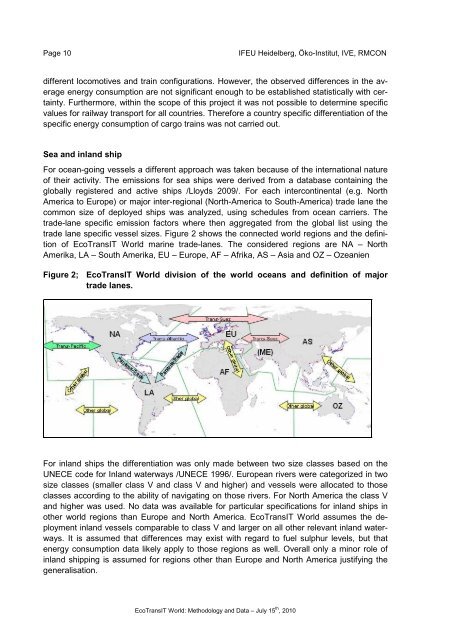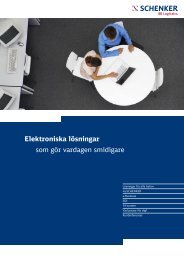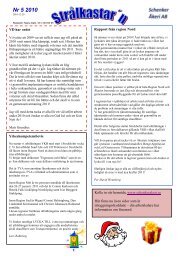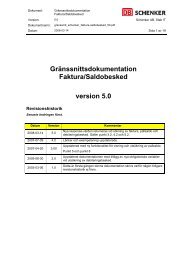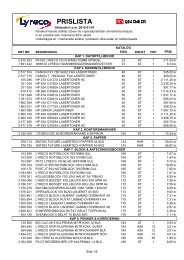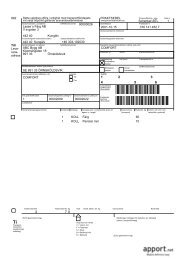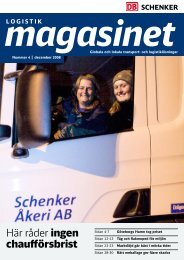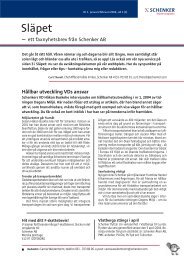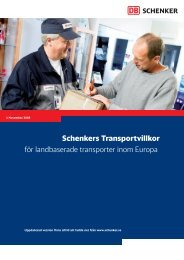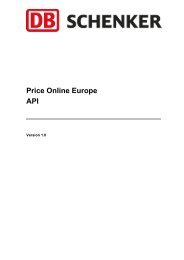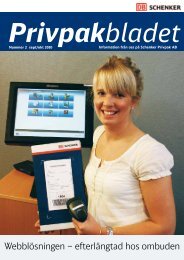Ecological Transport Information Tool for Worldwide ... - Schenker
Ecological Transport Information Tool for Worldwide ... - Schenker
Ecological Transport Information Tool for Worldwide ... - Schenker
You also want an ePaper? Increase the reach of your titles
YUMPU automatically turns print PDFs into web optimized ePapers that Google loves.
Page 10<br />
IFEU Heidelberg, Öko-Institut, IVE, RMCON<br />
different locomotives and train configurations. However, the observed differences in the average<br />
energy consumption are not significant enough to be established statistically with certainty.<br />
Furthermore, within the scope of this project it was not possible to determine specific<br />
values <strong>for</strong> railway transport <strong>for</strong> all countries. There<strong>for</strong>e a country specific differentiation of the<br />
specific energy consumption of cargo trains was not carried out.<br />
Sea and inland ship<br />
For ocean-going vessels a different approach was taken because of the international nature<br />
of their activity. The emissions <strong>for</strong> sea ships were derived from a database containing the<br />
globally registered and active ships /Lloyds 2009/. For each intercontinental (e.g. North<br />
America to Europe) or major inter-regional (North-America to South-America) trade lane the<br />
common size of deployed ships was analyzed, using schedules from ocean carriers. The<br />
trade-lane specific emission factors where then aggregated from the global list using the<br />
trade lane specific vessel sizes. Figure 2 shows the connected world regions and the definition<br />
of EcoTransIT World marine trade-lanes. The considered regions are NA – North<br />
Amerika, LA – South Amerika, EU – Europe, AF – Afrika, AS – Asia and OZ – Ozeanien<br />
Figure 2; EcoTransIT World division of the world oceans and definition of major<br />
trade lanes.<br />
For inland ships the differentiation was only made between two size classes based on the<br />
UNECE code <strong>for</strong> Inland waterways /UNECE 1996/. European rivers were categorized in two<br />
size classes (smaller class V and class V and higher) and vessels were allocated to those<br />
classes according to the ability of navigating on those rivers. For North America the class V<br />
and higher was used. No data was available <strong>for</strong> particular specifications <strong>for</strong> inland ships in<br />
other world regions than Europe and North America. EcoTransIT World assumes the deployment<br />
inland vessels comparable to class V and larger on all other relevant inland waterways.<br />
It is assumed that differences may exist with regard to fuel sulphur levels, but that<br />
energy consumption data likely apply to those regions as well. Overall only a minor role of<br />
inland shipping is assumed <strong>for</strong> regions other than Europe and North America justifying the<br />
generalisation.<br />
EcoTransIT World: Methodology and Data – July 15 th , 2010


